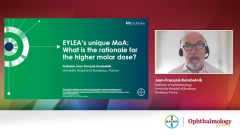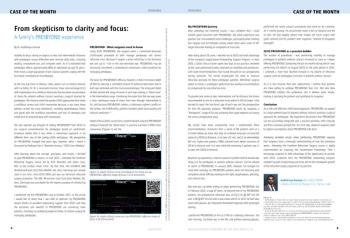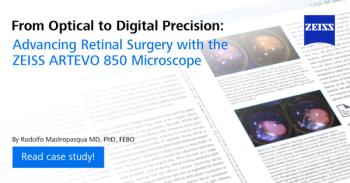
EYLEA’s unique MoA: What is the rationale for the higher molar dose?
Episodes in this series
Hello and welcome to this video series sponsored by Bayer in which we are going to explore Eylea 8 mg for the treatment of age-related macular degeneration and diabetic macular edema. I am Professor Jean-Francois Korobelnik. I'm working in Bordeaux at the University Hospital in France. In this video I will be talking about Eylea's unique mechanism of action and the rational for the higher molar dose. Before we get started, I'd like to share my disclosures. I have been compensated by Bayer for my participation in this video. First, let's explore how Eylea targets disease pathogenesis.
To do that, let's have a look at the Eylea molecule. Eylea is a recombinant fusion protein consisting of portion of human VEGF receptors 1 and 2 domains fused to the Fc portion of human IgG1. So, it works as a decoy for multiple targets: VEGF-A, VEGF-B, placental growth factor, and galectin-1. This is a pioneer for the multi-targeted therapeutic approach.
In fact, Eylea is the only widely approved agent that blocks all VEGF receptor 1 ligands and the key VEGF receptor 2 ligands.
So, let's talk about the molar dose of Eylea 8 mg and why it is so significant. Eylea 8 mg has the highest reported potency. It demonstrates a stronger binding affinity for VGF-A and it targets a broader range of molecules including VEGF-A, VEGF-B, PLGF, and galectin-1. Additionally, Eylea 8 mg has a 34% slower ocular clearance compared to its 2 mg counterpart.
Now, let's take a look at the rational for increasing the molar dose of Eylea.
As I mentioned, 8 mg dose has a slower ocular clearance than the 2 mg dose. In fact, 8 mg is estimated to remain in the eye for 6 weeks longer, on average, than the Eylea 2 mg.
Why is this significant? Well, with its four-fold higher molar dose compared with the Eylea 2 mg, Eylea 8 mg aims to achieve sustained disease control for all eligible patient groups, potentially addressing key unmet needs in retinal care.
So what would shifting the curve mean for patients with neovascular AMD and DME who currently experience a higher treatment burden? What would this mean for clinic capacity? As you can see on this illustrative model, shifting the curve on the right could mean increasing the treatment intervals by four to eight weeks, from eight-week intervals to eight or 12-weeks intervals, thus lowering the treatment burden and reducing clinic capacity issues.
Another potential benefit of longer acting agents is that they may extend the time between injections compared to current treatment options. With Eylea 2 mg, approximately a third of the patients in ALTAIR and ARIES trials received injections every eight weeks or less at year two. On the other end, the percentage of patients receiving Eylea 8 mg that had last assigned treatment interval of 8 weeks at week 96 in PULSAR and PHOTON was between 5 and 13% only.
So now, let's return to our illustrative model and take a closer look at patients who are currently able to achieve extended treatment intervals on the right of your slide.
You can see the green line that represents the higher molar dose, so that the patients can, in fact, achieve those extended intervals as a result with lower treatment burden.
Let's now take a closer look about what longer interval means really. For Eylea 2 mg, one study found that 42 to 46% of patients were on 16-week intervals at year 2. Whereas another study found that 27 to 30% of patients were at 16-week or greater intervals at year 2. By contrast, between 78 and 88% of patients receiving Eylea 8 mg in PULSAR and PHOTON had a last treatment interval of 16-weeks or greater at week 96. So this data strongly suggests that longer acting agents may extend the time between injections compared with current treatment options.
Now, let's put together all the pieces and see what impact this could have for the patient. Based on everything we've explored in this video, Eylea 8 mg has the potential for greater and longer lasting control of disease activity through lasting vision gains, rapid and resilient fluid control, and extended treatment intervals. Additionally, Eylea 8 mg has the safety profile that is consistent with the Eylea 2 mg. With this in mind, let's take one last look at the mechanism of action of Eylea to support the rational for higher molar dose. Eylea's unique mechanism of action and molecular properties contribute to a sustained suppression of VEGF which is the master regulator of disease pathology. With its four-fold higher molar dose and 34% slower ocular clearance than Eylea 2 mg, Eylea 8 mg shifts the curve for all eligible patient groups. As a result, Eylea 8 mg has the potential for greater and longer lasting control of disease activity through sustained disease control compared to Eylea 2 mg for eligible patients groups with neovascular AMD and DME. Thank you very much for watching.
Newsletter
Get the essential updates shaping the future of pharma manufacturing and compliance—subscribe today to Pharmaceutical Technology and never miss a breakthrough.














































